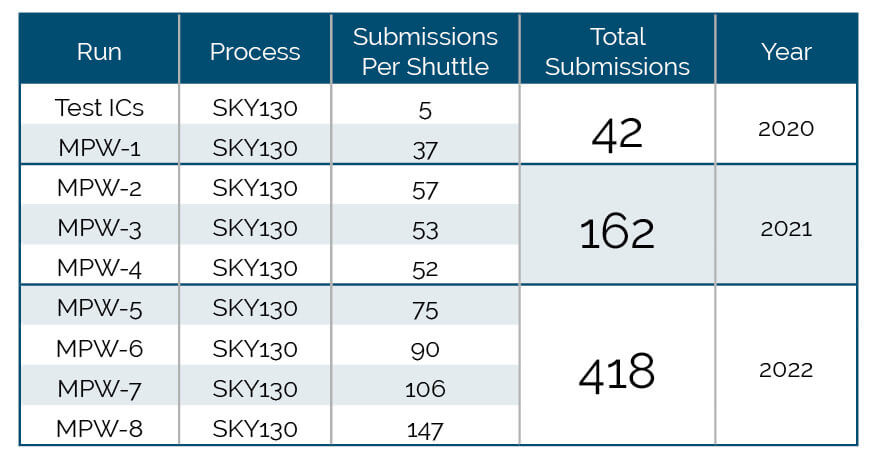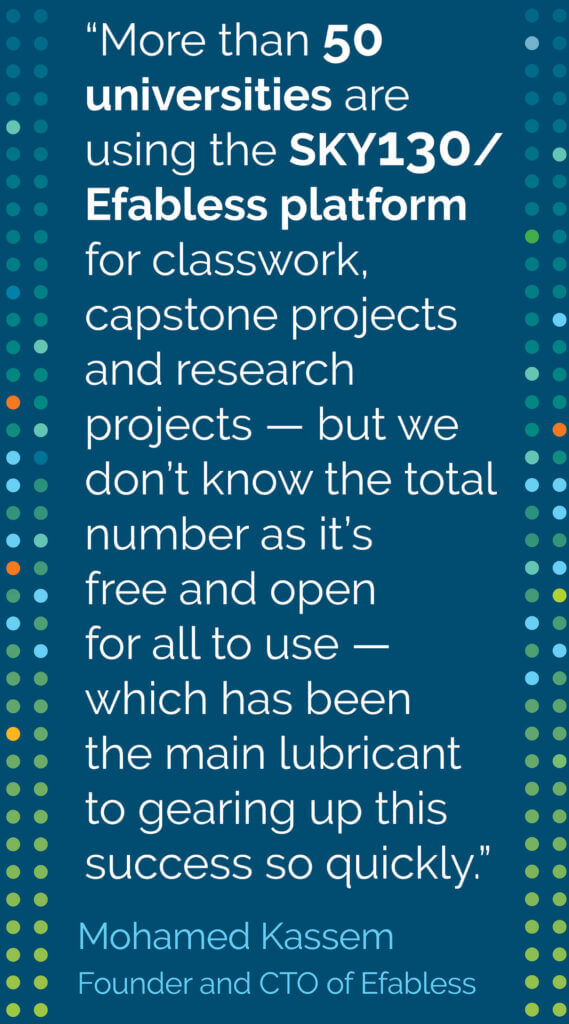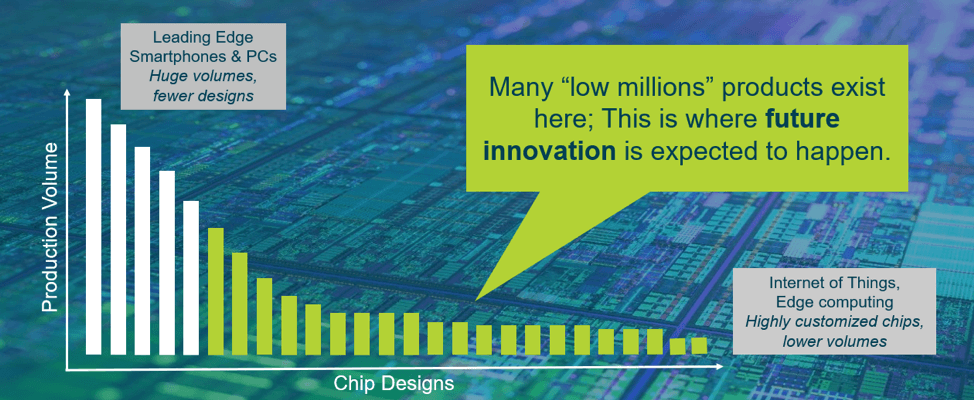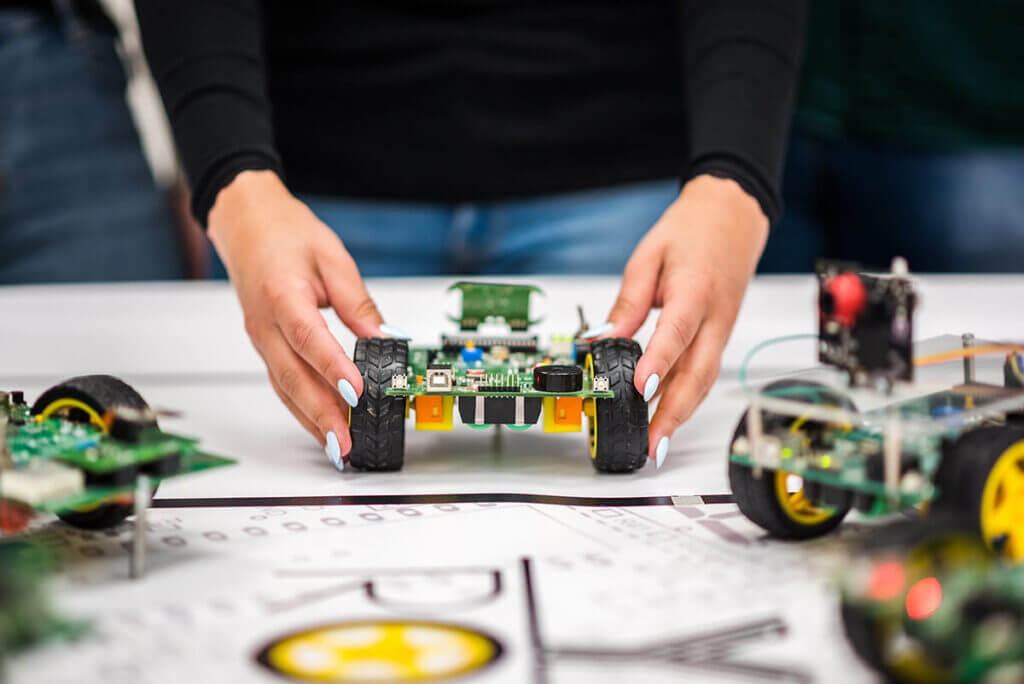
The open-source ecosystem sparks innovation, lowers barriers to chip design and paves a new path for global workforce development
by SkyWater CTO Steve Kosier
Three years ago, SkyWater, Efabless and Google teamed up to release the industry’s first open-source foundry Process Design Kit, or PDK, known as SKY130 — based on SkyWater’s volume 130 nm CMOS technology. The partnership gave designers worldwide free access to chip design technology to create new, manufacturable designs. While the focus of this effort was largely on revolutionizing technology realization for all — some exciting social developments also emerged.
Interested in an update, we sat down with SkyWater’s Chief Technology Officer Steve Kosier to talk about the SKY130 PDK — curious to learn how it’s helping the innovation ecosystem globally while introducing chip design skills to an organically developing talent pipeline — with free educational tools for anyone interested in developing a skillset as a chip designer.
The huge cost of chip design stifles innovation and cripples education
Semiconductor design costs grow exponentially with each new node. To use commercial tools and design a production-ready 130 nm chip, you can expect to spend about $5,000,000. Migrate to 65 nm, and you’ll need $20,000,000. If we move to the leading-edge technology, 5 nm, the bill can be as much as half a billion dollars. For 2 nm is even more expensive at $725,000,000. Obviously, such figures put chip design out of reach for an individual user.
There are other barriers to chip design too. You need Electronic Design Automation, or EDA tools, non-disclosure agreements, intellectual property agreements, access to fabrication and testing. For many aspiring chip designers, organizations, and creators of new products — these hurdles can be insurmountable.
In educational institutions, access to chip design tools that target manufacturable process flows can be limited and unaffordable — leaving students with theoretical knowledge but lacking practical experience. Furthermore, the inability to share information between institutions, reference prior designs by other researchers, or afford wafer fabrication makes educating and attracting students to semiconductor careers difficult.
What if the cost was closer to $0?
Enter the value proposition for open-source PDKs. Open source tools are free to all, which eliminates the cost to get started — unleashing creativity and making chip design available to more people. The Google-sponsored Open Multi Project Wafer, or Open MPW, Shuttle Program attracted designers from academia, commercial organizations and beyond, enabling market-relevant designs to be fabricated by people who traditionally would not have had the opportunity to design a chip.
In the first MPW run in 2020 there were 42 submissions and about 60% of the designs were submitted by non-chip design experts — demonstrating a significant untapped interest generated by putting design capability in the hands of non-traditional users. In subsequent MPW runs, the submission rate grew to 162 in 2021 and 418 in 2022.

No-cost tools and low-cost fabrication is democratizing high-end silicon design
 Our partner in this effort, Efabless, provides ChipIgite which consists of Caravel, a pre-designed carrier-chip along with an automated open-source design flow called OpenLane, making creating a chip easy and affordable. This rapid path to prototyping and low-volume production is ideal for educational institutions, startups, and individuals who want to design market-relevant products.
Our partner in this effort, Efabless, provides ChipIgite which consists of Caravel, a pre-designed carrier-chip along with an automated open-source design flow called OpenLane, making creating a chip easy and affordable. This rapid path to prototyping and low-volume production is ideal for educational institutions, startups, and individuals who want to design market-relevant products.
Co-founder and CTO of Efabless Mohamed Kassem explains, “The number of institutions of learning on SKY130 is rapidly increasing. More than 50 universities are using the SKY130/eFabless platform for classwork, capstone projects and research projects — but we don’t know the total number as it’s free and open for all to use — which has been the main lubricant to gearing up this success so quickly.”
In some cases, students who take such classes use slots on a ChipIgnite, which will be fabricated by SkyWater. ChipIgnite is scheduled in April, June, September and November so that students get silicon back the following session to test and demonstrate projects with working implementations.
All users appreciate:
- No legal agreements — All students, researchers, and professors access foundry technology, chip reference designs, EDA tools and design flows that are completely open-source. There are no NDAs or other legal requirements. All content can be downloaded from git repos. URL https://skywater-pdk.readthedocs.io/en/main/
- No export control restrictions — This makes it easy to provide access for all people.
- Freedom to collaborate — Share design files across teams and organizations, including GDS final layout files.
- Rapid design — Complete a design in a full chip within a single course or cycle of learning by leveraging reference designs and automated flows. By using the Caravel SoC on SKY130, it’s possible to complete a focused design goal quickly.
- Tiny Tapeout – This program allows a designer to go from idea to chip design in minutes. A student can now do a design for $50. An eight-year-old created a chip using this innovation.
- New research-focused tools — A new NIST and Google Nano Accelerator and Open Cryo PDK built on the SKY130 platform delivers the scale of open IP and multi project wafers to the research community.
- MPW shuttle program – The Google-funded MPW shuttles helped get this program started. While those initial eight shuttle runs have concluded, programs like Tiny Tapeout and ChipIgnite are available for designers to design and manufacture affordably.
130 nm CMOS is a proven workhorse for mixed-signal applications and ideal learning node
Opening development on this widely used and commercially relevant node is ideal because it has a large pool of existing IP given its maturity — something that’s valuable for seasoned and novice chip designers alike. The more advanced the node, the more design rules — and the longer it takes to validate and manufacture a chip.
One university professor who started teaching with SKY130 moved to a 16 nm node platform for a semester. She has returned to SKY130 saying that it was too hard for first-time chip designers to complete a chip using the 16 nm alternative. SKY130’s simplicity and compatibility with early education is essential to giving students a practical experience where they can learn and successfully create a chip.
A talented community is building the future in the “Innovation Tail”
The greatest chip production volumes serve leading edge applications such as smartphones, PCs, memory, etc. While they have huge volumes — they also have very few designs. On the other end, there is a very long tail where many millions of products exist. This is where future innovation is happening. It makes sense to make technology accessible to all so that we can improve what’s there and grow the knowledge base of the world.

Since SkyWater released its open source SKY130 PDK there are now more than 6,400 members in the Slack interactive discussion workspace and membership continues to grow! There are also 100+ channels including #analog-design, #courses and #riscv. The best part is that anyone can join here.
On Google-sponsored shuttle MPW-8, the fastest ever design creation rate emerged. A remarkable 147 unique market-ready manufacturable designs were submitted in a lottery for free fabrication. Although only 40 designs could be chosen for fabrication, the work and designs are still available for all to reference, use and improve.
There were many interesting designs submitted including sleep apnea devices, a flu detector, smart garden and image detection at the edge. These innovative designs speak to the whole purpose of the ecosystem: people can come up with their designs and share them with the world.
We need more people interested in semiconductor careers
 One of the challenges facing the semiconductor industry is a shortage of talent. As technology continues to advance, the demand for skilled professionals in semiconductor design and fabrication is growing. To address this issue, we need to capture the attention of younger students —those entering high school — to increase awareness earlier. In addition, we need to emphasize the value of semiconductor careers and make education and training more accessible.
One of the challenges facing the semiconductor industry is a shortage of talent. As technology continues to advance, the demand for skilled professionals in semiconductor design and fabrication is growing. To address this issue, we need to capture the attention of younger students —those entering high school — to increase awareness earlier. In addition, we need to emphasize the value of semiconductor careers and make education and training more accessible.
Open-source initiatives can play a pivotal role in workforce development by providing learning resources and hands-on experience opportunities for aspiring semiconductor professionals. We couldn’t do this before because of the large barriers to entry. Now with open-source, there are no questions. We can create textbooks, share resources, and create programs of learning that benefit everyone.
Start designing today at Efabless.com or Tiny Tapeout
The open-source revolution in semiconductor design is transforming an industry once shrouded in exclusivity into one that welcomes innovation from all corners of the globe. By lowering the cost of design tools, enabling affordable fabrication, and fostering a global community of chip designers, the open-source ecosystem is democratizing high-end silicon design.
In fact, SkyWater recently announced the availability of a new Cadence open-source PDK and reference design which will be available in the Cadence® Very Large-Scale Integration Fundamentals Education Kit. The kit teaches students how theories and concepts can be applied in the design of simple logic circuits and in the physical implementation of a simplified microprocessor. This is exciting news, and we anticipate more announcements like this soon.
It is inspiring seeing everyone using and making improvements to the SKY130 PDK. It takes everyone working together to improve the community and advance the state of open-source tools. If you have ever wanted to design a chip, now you can. It’s never been easier to get started.
I would encourage you to investigate the SKY130 PDK. Who knows — your design could solve a key problem, move rapidly to volume production, and improve the world!